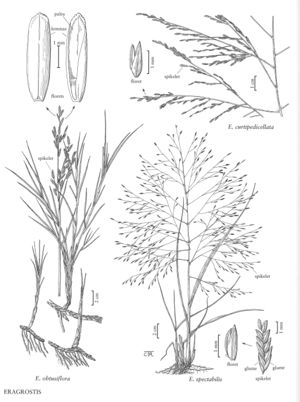Difference between revisions of "Eragrostis obtusiflora"
FNA>Volume Importer |
imported>Volume Importer |
||
| (2 intermediate revisions by the same user not shown) | |||
| Line 37: | Line 37: | ||
|publication year= | |publication year= | ||
|special status= | |special status= | ||
| − | |source xml=https:// | + | |source xml=https://bitbucket.org/aafc-mbb/fna-data-curation/src/200273ad09963decb8fc72550212de541d86569d/coarse_grained_fna_xml/V25/V25_142.xml |
|subfamily=Poaceae subfam. Chloridoideae | |subfamily=Poaceae subfam. Chloridoideae | ||
|tribe=Poaceae tribe Cynodonteae | |tribe=Poaceae tribe Cynodonteae | ||
Latest revision as of 17:56, 11 May 2021
Plants perennial; rhizomatous, sometimes also stoloniferous, with many innovations and scaly, sharp-tipped rhizomes 4-8 mm thick. Culms 15-40(50) cm, erect, stiff, hard. Sheaths hairy at the apices, hairs to 2 mm; ligules 0.2-0.4 mm, membranous, ciliate; blades 2-15 cm long, (1)2-4 mm wide, involute, arcuate, glabrous abaxially, scabrous adaxially, apices sharply pointed. Panicles terminal, 6-20(24) cm long, 2-8(12) cm wide, ovate, open or contracted; primary branches 1-8(15) cm, appressed or diverging up to 50° from the rachises; pulvini glabrous or not; pedicels 0-8 mm, appressed, lower pedicels on each branch shorter than 1 mm. Spikelets 8-14 mm long, 1.4-3 mm wide, ovate to lanceolate, stramineous with a reddish-purple tinge, with 5-10 florets; disarticulation basipetal, glumes persistent. Glumes unequal, chartaceous; lower glumes 2.4-3.6 mm; upper glumes 3-4.5 mm, sometimes 3-veined; lemmas 3.8-4.5 mm, ovate, leathery, 3(4, 5)-veined, lateral veins evident, greenish, upper margins hyaline, apices acute to obtuse, usually erose; paleas 3.8-4.5 mm, membranous, keels scabridulous, apices obtuse to truncate; anthers 3, 2-2.4 mm, purplish to yellowish. Caryopses 1.6-2 mm, ellipsoid, dorsally flattened, with a shallow adaxial groove, striate, reddish-brown. 2n = 40.
Discussion
Eragrostis obtusiflora is native to the southwestern United States and Mexico. It grows in dry or wet alkali flats, often in association with Distichlis and Sarcobatus, at 900-1400 m.
Selected References
None.
